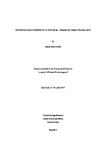Experience and Viewpoints in the Social Domain of Space Technology
| dc.contributor.supervisor | Punt, Michael | |
| dc.contributor.author | Griffin, Joanna Mary | |
| dc.contributor.other | Faculty of Arts, Humanities and Business | en_US |
| dc.date.accessioned | 2014-08-13T09:10:39Z | |
| dc.date.available | 2014-08-13T09:10:39Z | |
| dc.date.issued | 2014 | |
| dc.identifier | 10248111 | en_US |
| dc.identifier.uri | http://hdl.handle.net/10026.1/3084 | |
| dc.description.abstract |
This thesis is about how space technology is experienced in the social domain and how its purpose is recast from different viewpoints. The author is an artist and the approach taken foregrounds qualities of experience and viewpoint in which artists have a particular investment. This approach opens up the ways that affect, agency and authorship cross social domains that are directly and indirectly associated with the production of space technologies. A key focus is a group project led by the author that was initiated in response to the launch in October 2008 of the Chandrayaan-1 spacecraft by the Indian Space Research Organisation (ISRO). The project took place in Bengaluru, India where the spacecraft was built. Taking the ambivalence that surrounds the uses and purposes of space technologies as a starting point, a description of the spacecraft is developed from a number of viewpoints, including the mission scientists, public media and the participants of the artist-led project. The interventionist strategies of the project shed light on the ways that technologies can be accessed through their imaginaries and this has significance for large-scale technologies, such as spacecraft, for which physical access is delimited and much of the infrastructure is invisible or hidden from public view. The thesis proposes ways of reinstating missed qualities of viewpoint and experience within the affective spaces of space technology through the imperative to articulate first-person engagements with the world that is bound into artistic interpretation. What is further proposed is that by picturing the interrelations and flows of space technology in social domains through the lenses of experience and viewpoint, a 'technographic picture' is created that then becomes available as a tool with which to re-imagine spacefaring. This is a crucial addition to discussions about the interplay between science, technology and society that recognises the intimate spaces at the core of such large-scale concepts. It offers a new transdisciplinary modality that incorporates an artistic approach with which to make sense of the structurally ambivalent pursuits of spacefaring. | en_US |
| dc.language.iso | en | en_US |
| dc.publisher | Plymouth University | en_US |
| dc.subject | Space technology | en_US |
| dc.subject | Chandrayaan | en_US |
| dc.subject | Artistic practice | en_US |
| dc.subject | Technography | en_US |
| dc.subject | Visuality | en_US |
| dc.subject | Indian space programme | en_US |
| dc.subject | ISRO | en_US |
| dc.subject | Moon Vehicle | en_US |
| dc.subject | Imaginaries | en_US |
| dc.subject | Artist-led | en_US |
| dc.subject | Subaltern studies | en_US |
| dc.subject | Satellite Instructional Television Experiment | en_US |
| dc.title | Experience and Viewpoints in the Social Domain of Space Technology | en_US |
| dc.type | Thesis | |
| plymouth.version | Full version | en_US |
| dc.identifier.doi | http://dx.doi.org/10.24382/4880 |
Files in this item
This item appears in the following Collection(s)
-
01 Research Theses Main Collection
Research Theses Main


